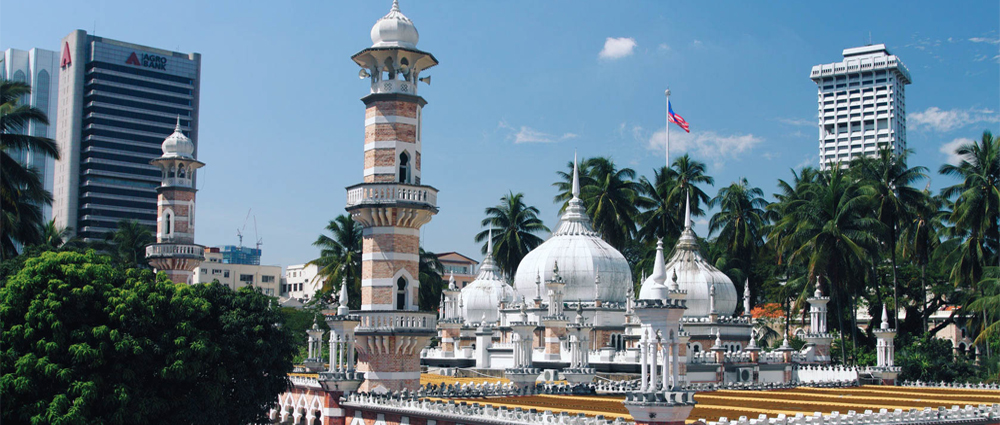As home to a large Muslim population, Malaysia is a natural destination for Muslim-friendly travel. The country has an abundance of halal food, with a diversity of options aimed at serving the taste buds of its well-travelled citizens including halal versions of Italian, Japanese, Korean and Chinese favourites, while the Bukit Bintang shopping hotspot features a tasty array of Arabic food offerings.
Walk around the capital, Kuala Lumpur, and you will find no shortage of mosques and prayer facilities for Muslim believers, many of which showcase eye-catching designs, from the more traditional to the latest contemporary aesthetics. Hotels and other facilities are sensitive to Muslim needs ensuring that service is seamless and friendly.
Meanwhile, Malaysia’s fashion-conscious local populace are decked out in a variety of Islamic ensembles, most prominently the younger hijabster set with their stylish takes combining the traditional with the modern and global. Even the ubiquitous local baju kurung has gone through dizzying permutations as fashion trends come and go. Multinational brands are recognising this trend as evidenced by Uniqlo’s decision to use Yuna, a Malaysian singer gaining global fame, as the face of their international modest fashion line.
Such is KL’s strength in presenting its Islamic credentials to the world that Malaysia has topped Thomson Reuters and Dubai Islamic Economy Development Centre’s (DIEDC) Global Islamic Economy Indicator (GIEI) yet again in 2017, ahead of countries such as the UAE, Saudi Arabia and Qatar. Malaysia also came first in the MasterCard Global Muslim Travel Index (GMTI) for the third year running.
It’s no coincidence that Malaysia is sitting pretty at the top. The success is driven by strong government initiatives to promote and brand Malaysia as an international Islamic tourist destination. In 2009, the Islamic Tourism Centre was set up to facilitate this transformation. As of 2017, ITC figures showed 5 million Muslim visitors to KL annually.
Zulkifly Md Said, director of the country’s Islamic Tourism Centre, believes that Malaysia’s multiculturalism has made the country comfortable with being flexible in catering to differing religious outlooks. “It’s not so complicated. Our Muslim visitors want something that is comfortable, but at the same time something that is a little different,” he told the Guardian.
Attractions include architectural designs featuring unique Islamic architecture. The Masjid Jamek and Masjid Negara are two of KL’s city centre icons, the former built more than a century ago at the river confluence where the city was founded and designed by Arthur Benison Hubback with Neo-Moorish architecture reminiscent of colonial buildings in India. Masjid Negara, on the other hand, is a modernist marvel that serves as an homage to the country’s post-independence identity.
According to Fazal Bahardeen, CEO and founder of Crescent Rating, Malaysia has capitalized on the need for more travel options for Muslim visitors. “Many Muslims, especially from the Middle East, found it difficult to travel to traditional tourist destinations like Europe and the US,” he told the Guardian. “Malaysia was one of the first countries to realize the potential of this market.”
This strategy has paid off handsomely for Malaysia. It now has a significant lead in this lucrative market, looking set to capture US$220 billion by 2020. New developments have continued this trend, such as the emphasis on Islamic finance and design principals at the Tun Razak Exchange (TRX).
The aim is to make TRX an international finance and tourist hub featuring a strong Islamic component alongside state-of-the-art infrastructure and facilities. No detail is too small, with even the MRT station sporting an “Islamic Corporate” design throughout.
“We are definitely seeing the influence of a new breed of young travellers, millennials, and Gen Z who are combining technology with a real desire to explore the world while still adhering to their faith-based needs,” Fazal Bahardeen explained. “They will be the driving force for the next phase of growth.”
“These young travellers want greater choice, unique experiences, and constant connectivity which can be seen with the growth of other Muslim lifestyle segments such as Halal food and modest fashion, which link perfectly with the travel market,” he said.





